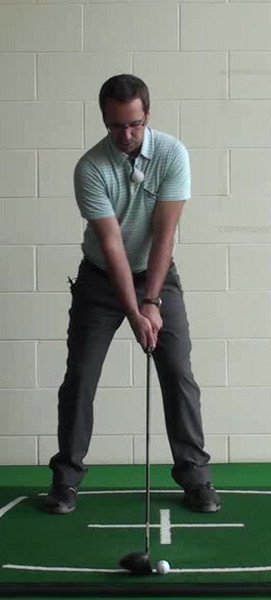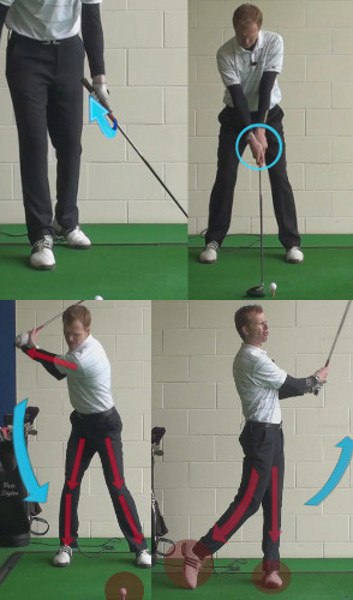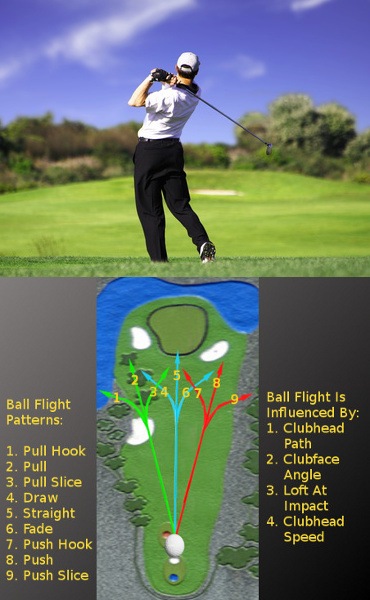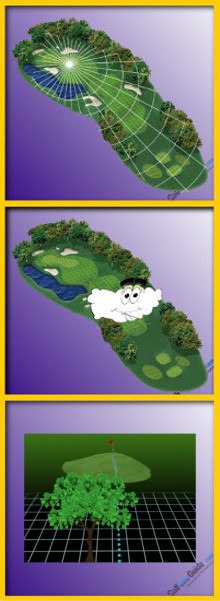Pulling out the driver for a shot from the fairway might seem like a risky play, but if the circumstances are right, it's actually quite safe. In fact, the first step when considering the “driver off the deck” is assessing your risk factors.

First of all, you probably shouldn't try it if you tend to spray or mishit your driver off the tee. But if you're reasonably consistent with the big stick, here's a checklist for giving it a go sans tee:
When all those elements are in place, here's how to proceed:
The most common mishit with the un-teed driver is a thin or topped shot, but provided the situation is amenable – e.g. there are no hazards to carry -- the worst-case scenario is a ball that rolls down the fairway a decent distance.

When and How to Hit Driver from the Fairway
The driver is a club that is used almost exclusively from the tee. Of course, even if you have only been golfing for a short period of time, you already knew that. The driver is the favorite club of many golfers because it is the one that is capable of launching the ball hundreds of yards down the fairway (when in the right hands). Countless golfers look forward to starting each par four or par five hole with a mighty lash at the driver – and there is a good chance you count yourself among that group as well.
However, did you know that you can actually put your driver to use elsewhere on the course? Specifically, you can use your driver when in the fairway to hit powerful shots that may travel further than the shots you could hit with your fairway woods or long irons. To be sure, hitting the driver from the fairway is a significant challenge, but it is certainly not impossible. Many professional golfers will pull this shot out of the bag from time to time when they are looking for maximum distance from the fairway, and you can learn from their example. The driver from the fairway is not a shot you will ever use with great frequency, but it can come in handy when you really need it.
There are two parts to the equation of this shot that you need to understand before it can become a reliable piece of your game. First, you need to understand how to hit the ball off of the fairway with your driver. While you are going to generally use your standard golf swing, there are some modifications that need to be made to your technique in order to produce quality results. Second, you will need to know when is the right time to reach for the driver from a fairway lie. There are some circumstances where making this choice can lead to great outcomes – and there are other circumstances where it will almost inevitably lead to failure. Just as with any other shot you hit on the golf course, decision making is going to be critical when it comes to playing your driver from the short grass.
Of course, it is important that you wait to try this shot out on the course until you have already built some confidence with it on the range. It is a mistake to try any new shot on the course before it has been tested and refined in the practice area, and that is certainly true in this case. Simply hitting a couple of drivers from fairway lies before your round doesn't really count as practice, either – you need to work on this shot over a period of several practice sessions before it should be trusted to handle duty during an actual round of golf.
All of the content below is based on a right handed golfer. If you happen to play left handed, please be sure to reverse the directions as necessary.

How to Hit Your Driver from the Short Grass
You don't want to make any drastic changes to your swing mechanics when preparing to hit a shot with your driver out of the fairway. The same technique that you used from the tee to drive your ball into the fairway is the same basic technique that you are going to use to hit this shot. With that said, there are a few minor adjustments that will need to be made in order to achieve the best possible results. Consult the list below to make all of the necessary changes to see success when hitting the driver from the fairway.
- Move the ball to the middle of your stance. The first change that you need to make is to move the ball to the middle of your stance, rather than playing it up by your front foot as you would do when hitting from a tee. Off the tee, you are trying to hit up on the ball slightly, so it makes sense to keep the ball positioned nearly the front of your stance. However, from the fairway, you need to make contact when the club is moving parallel to the ground, meaning the ball needs to be placed near the middle of your stance. You will have to experiment a little bit to find the perfect ball position for your swing, but just slightly forward of center is a good starting point for most players.
- Choke down slightly. You need to have great control over the club throughout this swing if you are going to make good contact, so consider choking down on the grip of your driver slightly at address. By making the club play a bit shorter, you should be able to better control the club head, meaning you should find the sweet spot at impact more frequently. Don't worry about losing distance by making this adjustment, as any minor loss in swing speed should be made up for by the improvement in the quality of contact that you can achieve.
- Stay level. As you make this swing, it is incredibly important that you keep your body as level as possible throughout the motion. That means that the amount of flex in your knees should remain stable as you move back and through, and you should avoid letting your head move up and down excessively. Again, this is all about quality of contact. You have to catch the ball perfectly clean if you are going to get a good result from this shot, and keeping your body level in both the backswing and downswing is crucial to clean contact. Many golfers make the mistake of trying to hit this shot extra hard, which causes them to lift up or dip down as they approach the ball. Don't make this mistake – hold yourself level and trust the club to provide plenty of power at impact.
- Forget about a draw. In order to draw the golf ball, you have to swing from the inside as you approach impact. That is fine when the ball is on a tee, or when you are playing an iron shot from the fairway, but it is nearly impossible to accomplish consistently when you are trying to hit the driver off of the short grass. If you attempt to hit a draw with this shot, there is a good chance you will hit the shot fat – meaning you will hit the ground with the club before you hit the ball. To make it easier to achieve good contact at impact, it is a better idea to set yourself up for a cut rather than a draw. Swing slightly from the outside-in through the ball, and pick a target that allows for a slight left to right curve in the air.
- Be aggressive. You should always be striving to accelerate the club head through impact no matter what kind of shot you are hitting – but that point is particularly important when trying to strike your driver from the fairway. This kind of shot requires plenty of speed through the hit, and you aren't going to be able to generate enough speed if you are tentative with your swing. Once you decide that you are going to attempt this shot, you need to be fully committed to making it work. If there is any doubt in your mind before starting the swing, step back and consider using a club that will give you more confidence.
As you can see, none of the changes on this list are particularly drastic. You aren't going to need to radically change the way you swing the club in order to hit the driver from a fairway lie – rather, you are just going to need to make some simple adjustments. While practicing this shot on the range, use the points on the list above to adapt your technique as necessary and you should soon start to see some positive results. This is always going to be a challenging shot, so you should expect to hit a bad one from time to time, but it is possible to attain reasonable consistency once you put in the work.

Troubleshooting
As you get started in the process of learning this shot, there are bound to be a few 'bumps in the road'. During your first practice session, for instance, you will probably hit a few good shots mixed in with a bunch of bad ones. While these early struggles are to be expected, you will need to know what to do in order to get things turned around. With that in mind, the list below includes some of the common problems that players encounter when learning how to hit their driver from the fairway, along with the likely solution.
- Hitting it fat. This is by far the most common problem, and it was briefly highlighted above. If you attack the ball from the inside – as you would do when trying to hit a draw – you are likely to catch the turf before the ball, leading to a fat shot that only travels a short distance. The simple solution to this problem is to focus on hitting a cut, which will promote an outside-in path. Also, make sure you are turning your hips aggressively through the hitting area to enable the club head to reach the ball in time. A lackluster hip turn can lead to fat contact with any of your clubs, so that area of the swing should always be a focus when you start to catch the ball heavy.
- Failing to get the ball off the ground. If you are only able to roll the ball along the ground when trying this shot, even though you feel like you are making good contact, you likely aren't generating enough speed to put lift on the shot. Do your best to add speed at the bottom of the swing without losing track of your mechanics at the same time. If you feel like you have maxed out your swing speed and the ball still won't get off the ground, you may need to forget about this shot and simply use a fairway wood moving forward.
- Hitting a big slice. While it is true that you want to attack this shot from the outside-in, you don't want to take things too far in that direction. If you swing too much from the outside, you will impart a high rate of left to right spin on the ball, and a slice will be the result. Work on straightening out your path so that you come into impact only slightly from the outside. The perfect path for this kind of shot is one that results in a small fade rather than a big slice.
If you are going to learn how to hit this shot with any measure of consistency, you are going to have to bring your patience to the process. This is not a shot that is easy to learn, and it is not one that is going to find its way into your game overnight. As you deal with the struggles that are common early on in the process, use the points above to help get you back on the right track.

When You Use Your Driver from the Fairway
Now that you (hopefully) are able to hit this shot with relative consistency, you need to understand when you should pull it out of the bag. This is not going to be a shot that is called for very often – in fact, you will go through most rounds without even using it once. However, when the situation does arise that calls for a driver from the fairway, you will be happy you took the time to learn how to play the shot. Even if the opportunity to hit this shot only comes up a few times during the golfing year, those few times could lead to some of the most memorable shots you have hit in your life.
The following situations are great opportunities to play your driver from the fairway.
- Going for a par five in two. Of course, this is the main opportunity that you will have to use your driver when your ball is sitting in the fairway. If you would like to have a go at reaching the green in two – but you don't think you can get there with your three wood – the driver may be the best option you have. Before making your club selection, however, you need to take a look at the lay of the land between you and the hole. A driver struck from a fairway lie is unlikely to climb high in the air, so you will need to have plenty of grass in front of you for the ball to bounce and roll. If there is a hazard like a pond or bunker short of the green that you will need to carry, the driver is probably not going to be the right choice. Also, you will want to think about where you are going to be leaving your ball with this shot if you don't actually make it onto the green. If you come up short, will you have an easy up and down for your birdie? If not, you might again want to think about another route. It is exciting to make an eagle on a par five, but your goal should always be to give yourself the best possible chance to make a birdie.
- Long approach into the wind. You don't have to be on a par five to use your driver from a fairway lie. For instance, if you are playing a long par four that happens to be playing into the wind, you might need the driver to reach the green in two shots. Using a driver in this situation is a wise idea because it will offer you the distance you are looking for, along with a low trajectory that should help you avoid the wind. The same caveats that were listed above apply to this shot however, as you will still need to plenty of run up space to make the shot work. The driver from the fairway should never be considered a good option when a forced carry is part of the equation.
- Avoiding overhanging branches. This is a scenario that you likely won't face very often, but it can come up from time to time depending on the type of courses you play. If you find your ball in the fairway, yet also with some trees between you and the target (often the case on a hole with a dogleg), you might decide to reach for the driver as a way to keep the ball under the branches of the trees. Hitting your driver from the fairway is one of the easiest ways to keep the ball low, which is the critical element of this kind of shot. Unless you are particularly adept at hitting low punch shots with your long irons, playing a shot with your driver in this scenario makes a lot of sense.
Most likely, you will find even more opportunities than just the three listed above to use your driver shot from a fairway lie. As you gain confidence through executing the shot successfully on the course a few times, you will become more and more willing to reach for it as circumstances allow. As long as you are smart and able to pick your spots wisely, you should be able to lower your scores thanks to the help of this unique shot.

Understanding the Conditions
There is one last point that needs to be made regarding this shot, and it has to do with the conditions of the course that you are playing on a given day. Perhaps more than any other shot in golf, the distance that you are able to achieve with the driver from the fairway is going to be dramatically affected by the course conditions. Since the ball is only going to carry a short distance in the air before bouncing and rolling the rest of the way, the condition of the ground in front of you will have a lot to say about how much distance you can achieve in the end.
For example, if you are playing on a course that is dry and firm at the moment, you could easily see your ball bounce and roll for more than 100 yards. If it started out by carrying 150 in the air, that means you could hit this shot 250 yards when the conditions are right. On the other hand, if the course is soft from recent rain, that bounce and roll number could be cut down to just 20 or 30 yards. In that case, you might not even get 200 yards total out of the shot, meaning you would almost certainly be better off choosing a different club.
Part of playing good golf comes down to understanding the conditions that you are facing, so you should always be paying close attention to things like the firmness of the turf, the temperature of the air, the wind, and more. When you have firm turf (and plenty of it), the driver from the fairway is a viable option to achieve great distance from a low shot. However, if soft conditions are the order of the day, you will likely want to leave this shot in the bag until things dry out.
You won't want to hit your driver from the fairway very often, but it certainly is a nice weapon to have available to you from time to time. When the design of the hole in front of you and the course conditions come together just right, you can pull the driver out for a fairway shot and potentially achieve some impressive results. Remember, only put this shot into use after you have practiced it on the range, and only hit it when you are completely confident that you are making the right choice.






